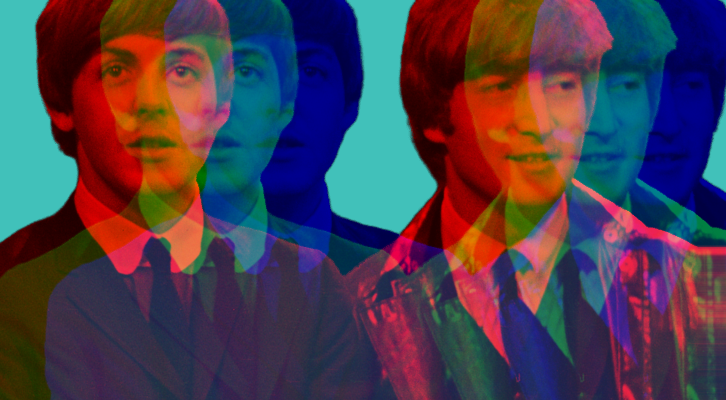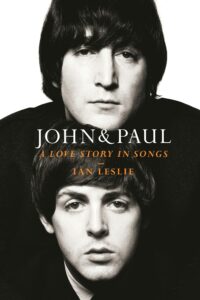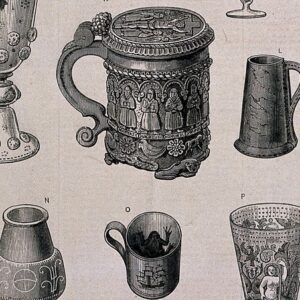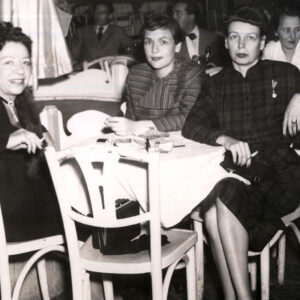
On “Eleanor Rigby” as a Product of the Combined Genius of John Lennon and Paul McCartney
Ian Leslie Considers the Musical Camaraderie and Creative Rivalry That Produced an Iconic Song
In the early months of 1966, whenever Paul McCartney sat down at a piano, wherever it was, he would start tinkering with a song he called “Miss Daisy Hawkins.” From the moment he found its first five syllabic notes, the song seems to have found its themes: loneliness, futility, the end of life. McCartney was twenty-three. Without discussing it, both John Lennon and Paul came back from their break with songs about death, written from a detached, omniscient perspective.
In “Tomorrow Never Knows” John dispenses instruction from the mountaintop. In two minutes, “Eleanor Rigby” captures the entire lives of two individuals in a series of stark images. Musically, both songs are stripped down to a few parts in order to distill and intensify some essence. “Eleanor Rigby” confines itself to a narrow melodic range and the song has minimal harmonic development: like “Tomorrow Never Knows,” it alternates between just two chords.
Set in a minor key, its tightly wound, almost claustrophobic verse plays out over an accompaniment—a string section arranged by George Martin—that sticks close to the tonic, except when the cellos burst into a galloping run up the scale. This section is joined to a refrain in which the singer asks where all the lonely people come from while the cellos play a Bach-style descending line. Paul is joined by John and George for a second refrain—“Ah, look at all the lonely people”—in which the melody soars up before tailing off. In the final section, the two refrains come together in contrapuntal harmony. The mood throughout is tense and austere.
It’s hard to explain “Eleanor Rigby.” Nobody had created a pop song like this before. Its cultural ubiquity has stopped us from noticing how strange it is.
As a teenager, Paul used to run errands for an elderly woman in his neighborhood. He wondered what it was like to be her. In Hamburg, he befriended the old woman who ran the bathroom at the Kaiserkeller and sold pills to the customers. He was curious about those left on their own, unmoored from family. Still, it’s hard to explain “Eleanor Rigby.” Nobody had created a pop song like this before. Its cultural ubiquity has stopped us from noticing how strange it is—at least as radical, in its way, as “Tomorrow Never Knows,” which John came up with after hearing Paul play “Eleanor Rigby.” Both John and Paul were living up to Arthur Schopenhauer’s definition of genius: unlike talent, which hits a target nobody else can reach, genius hits a target nobody else can see.
*
Since Lennon became known as “the literary Beatle” McCartney’s talents as a lyricist have been overlooked. His feel for words is essentially musical and sensual rather than semantic. As a boy, he drank in the ecstatic rhyming in classics like “The Honeymoon Song,” one of those pre-rock-and-roll songs that he insisted be part of the Beatles’ repertoire early on. In a performance of it the Beatles made at the BBC you can hear him reveling in lines like “The skies are as bright as your eyes / The horizon is open.” Internal rhymes and half rhymes abound in his lyrics—little irruptions of pleasure.
As a singer, he rolls around in word-sounds like a cat in a pool of sunshine. From the reprise of the Sgt. Pepper’s title track: “Sergeant Pepper’s one and only lonely hearts club band.” In “Mother Nature’s Son” there is the ravishing line “Swaying daisies sing a lazy song beneath the sun.” McCartney’s own favorite line in “Penny Lane” is about the fireman: “He likes to keep his fire engine clean / It’s a clean machine” (“machine” rhyming with “clean” twice over). Walter Everett notes that McCartney knew, instinctively, how to write lines that enact their meaning in sound. In “She’s Leaving Home,” “She goes downstairs to the kitchen / clutching her handkerchief” conveys the snuffling of someone struggling to suppress their sobs. Like John, he loved wordplay (in “What You’re Doing,” he rhymed “doin’” with “blue an’[d]”; “runnin’” with “fun in”), but he rarely tried to emulate John’s sophisticated vocabulary or densely surrealistic imagery. He preferred to write lyrics that seem simple on the surface but which pulsate with meanings, like the overtones surrounding a single note. He knew how to communicate an idea with almost brutal economy, as in “For No One” (“The day breaks / Your mind aches”). He also liked to be suavely witty, as in “Lovely Rita” (“When it gets dark I tow your heart away”) and “Back in the USSR” (“Let me hear your balalaikas ringing out”).
In “Eleanor Rigby” McCartney uses the sounds of words as connecting fibers; Everett points to how “Paul grabs a sound and hangs on to it.” In the same place in each verse, we get “rice” paired with “face,” “church” with “dirt”—not rhymes so much as matching colors. There is a discipline to McCartney’s structure. Each line of the verse opens with a five-syllable phrase in which the fourth syllable is stressed (“Eleanor Rigby / Waits at the window / Father McKenzie / Look at him working”). These opening phrases are mirrored by the closing phrases of each line in “Tomorrow Never Knows”—you can sing “it is not dying” or “it is believing” in their place. Paul ends each line of “Eleanor Rigby” with a little commentary or question on what has preceded it—“Lives in a dream / Who is it for? / No one comes near”—similar to the God’s-eye mode of “Tomorrow Never Knows.” The two songs speak to each other.
*
In “Tomorrow Never Knows,” however distant Lennon’s voice sounds, the message is ultimately a soothing one. “Eleanor Rigby” offers no comfort. It turns an unflinching, even acerbic gaze on its characters. A woman picks up rice in a church, tidying up after a wedding. Oblivious to joy, she lives in a dream and wears a face that nobody sees. In the second verse, we meet Father McKenzie, writing his sermon for nobody. In the third and final verse, they are brought together without coming together. He buries her in a perfunctory ritual. Everything is concise, economical, and devastating: no one was saved.
Around this time, both John and Paul were dwelling on the decline of Christianity. In Cleave’s interview, John contrasted it with the rise in popularity of the Beatles, a relatively mild observation that came back to haunt him. But in “Eleanor Rigby” Paul slid a knife into the bone. This was something of a pattern. When Lennon was outspoken, everyone noticed. Paul’s scorn and aggression were either subtly disguised, or direct but overlooked. In his Cleave interview he described America as “a lousy country” for the way it treated its Black citizens. In 1966 he told David Frost, “Americans seem to believe that money is it” and “They believe in it all the time…[It’s] frightening.” To Cleave, he was contemptuous of America’s pretensions to morality:
There they were in America, all getting house-trained for adulthood with their indisputable principle of life: short hair equals men; long hair equals women. Well, we got rid of that small convention for them. You can’t kid me the last generation were any more moral than we are. They hid it better.
The Beatles were due to visit America later that year. Brian Epstein was concerned that John was being too political when he said he worried about the war in Vietnam. McCartney blithely disparaged the moral character of America and Americans—and nobody minded.
After A Hard Day’s Night the Beatles had distinct personas in the minds of the public: vividly drawn but crude cartoons. Ringo was the doleful clown, George quiet but deep. John was the Beatle with the sharp tongue and scathing wit, Paul the cute and charming one. The Beatles conspired to create these masks but by 1966 they were weary of them. The year before, the journalist Ray Coleman asked Lennon how he felt about being known as “the cynical one.” He replied:
When I meet intelligent and hip people, I have to be on my toes not to disillusion them. The people who have fallen for my image and publicity go to Paul…Paul can be very cynical and much more biting than me when he’s driven to it. ’Course, he’s got more patience. But he can carve people up in no time at all, when he’s pushed. He hits the nail right on the head and doesn’t beat around the bush, does Paul.
That McCartney’s harsh side went unnoticed had a lot to do with how he looked. Lennon’s aquiline nose and narrow eyes (often narrowed because he couldn’t see far) made him look sharp and judgmental. McCartney’s winsome eyes and neatly arranged features made him look like a baby, or a cartoon of a little girl. It was hard to believe anyone so cute could be callous. Paul was also more socially facile. This wasn’t just a front—he did genuinely like people and wanted them to feel at ease. In private, though, he could be demanding of aides and associates, and blunt to the point of rudeness. Epstein, in his memoir, describes Paul as “temperamental and moody and difficult to deal with…he is a great one for not wishing to hear about things.” Maureen Cleave highlighted his “shrivelling wit” and “critical intelligence.”
In pre-fame letters and in the group’s first interview, in November 1962, McCartney explicitly identified Lennon as the leader. Journalists habitually referred to Lennon as the “Chief Beatle.” But if Lennon was the group’s founder and figurehead, it was McCartney who propelled it forward; who taught Lennon how to play the guitar properly; who recruited George; who did the most to push Stuart out; who chased, harried, and wheedled promoters; who set the bar ever higher in the studio; who insisted that the group keep moving.
Harrison told Tony Barrow that when he joined the Quarry Men in 1958, Paul already seemed to be the decision-maker: “I knew perfectly well that this was John’s band and John was my hero, my idol, but from the way Paul talked he gave every indication that he was the real leader, the one who dictated what the Quarry Men would do and where they would be going as a group.” Cleave described Lennon’s presence as regal, comparing him to Henry VIII. We may imagine McCartney as Wolsey or Cromwell: chief diplomat or consigliere, directing affairs of state from beside the throne.
The Hard Day’s Night personas had some truth to them: Lennon was scabrously witty; McCartney did know when to smile and charm, and he did write heartfelt love songs. But you only have to change the angle of view by an inch or so to see them very differently. For certain people, Lennon’s heart swelled uncontrollably. His vituperation was the flipside of a tendency for headlong infatuation. McCartney was emotionally intense: anger, jealousy, and resentment bubbled away underneath his pleasant exterior. “Yesterday,” for which McCartney gained a reputation as a romantic balladeer, is a song of despair. “Eleanor Rigby” is often described as melancholy, but there is a cold fury to it, too. You can hear Paul’s latent anger at the meaninglessness of his mother’s death, and at the false consolations of a religion he did not believe in. When McCartney asked Martin to give the song a “biting” string arrangement, the model they turned to was the violins in Psycho (1960).
*
“Eleanor Rigby” was another of McCartney’s slow hunches: it took him at least three months to write. A dinner party hosted by Cynthia and John at Kenwood proved to be a staging post on the way to its completion. After dinner, McCartney played his song on guitar to a few Beatles intimates, including John’s friend Pete Shotton, and invited suggestions for how to finish it. He had the first two verses with their two characters, Eleanor Rigby and Father McKenzie (then “Father McCartney”), but hadn’t yet worked out a third verse. Shotton (according to his memoir) said, “Why don’t you have Eleanor Rigby dying and Father McKenzie doing the burial service for her?” At this, Lennon blurted out, “I don’t think you understand what we’re trying to get at, Pete.” He said it with such vehemence that the gathering broke up.
As soon as the world heard “Eleanor Rigby,” it was hailed as a masterpiece, specifically for the poetic quality of its lyrics. But John was meant to be the “literary Beatle.”
Shotton’s account is indirectly corroborated by a story told by Lennon in 1980 that sounds like it was about the same incident, recalled slightly differently.
By that time, he [Paul] didn’t want to ask for my help, and we were sitting around with Mal Evans [the Beatles’ faithful roadie and assistant] and Neil Aspinall, so he said to us, “Hey you guys, finish up the lyrics.” Now, I was there with Mal, a telephone installer who was our road manager, and Neil who was a student accountant, and I was insulted and hurt that Paul had just thrown it out in the air.
He actually meant he wanted me to do it, and of course there isn’t a line of theirs in the song because I finally went off to a room with Paul and we finished the song.
The first verse was Paul’s, he said, “and the rest are basically mine.” Lennon persistently laid claim to at least half the song without much apparent justification. In a 1970 interview, he said he’d written “a good half of the lyrics or more”; he repeated the claim in a letter to Melody Maker in 1971. In 1972 he told the journalist Ray Connolly he’d written 70 percent of the lyrics and said the same to another journalist in 1980. Connolly, despite being sympathetic to Lennon, didn’t believe him for a moment. Pete Shotton—John’s friend—said John’s contribution was “virtually nil.” McCartney put it at about 20 percent.
Lennon’s urge to exaggerate is understandable. As soon as the world heard “Eleanor Rigby,” it was hailed as a masterpiece, specifically for the poetic quality of its lyrics. But John was meant to be the “literary Beatle.” So whenever John was at his most insecure—in the wake of the breakup, and in 1980, when he stepped back into the limelight after several years out of it—it became important to lay claim to “Eleanor Rigby.” Note how insulted he is by the idea that someone ordinary—a telephone installer, an accountant—might contribute to a Lennon-McCartney song. McCartney’s willingness to accept ideas from others felt like a repudiation of his own genius.
For years, McCartney gave a pretty detailed account of how “Eleanor Rigby” got its name. He landed on “Eleanor” first, borrowing it from the actress Eleanor Bron, who played the female lead in Help! Next, he cast around for a surname with two syllables. In February 1966 he drove down to Bristol to see Jane Asher perform in a play, and while there he noticed a sign on a wine merchant’s storefront that read, “Rigby & Evens Ltd.” So that was how it happened. Except, in the early 1980s, somebody pointed out that there is a gravestone in the cemetery next to St. Peter’s church in Woolton, Liverpool, that bears the name Eleanor Rigby. Paul knew that church well: it was where he first met John Lennon. He and John had walked through that graveyard many times. When McCartney found out about this, he dismissed it, at first.
Later on, he conceded that he may have subconsciously picked up the name from the gravestone. (The gravestone in question isn’t even for Eleanor Rigby herself, but her grandfather; her name is farther down.) I can understand his reluctance—he knew his own story—but the idea that he coincidentally landed on the name, for a song about a woman who “died in the church,” seems implausible. However deeply in his mind her name was buried, it had been saved.
__________________________________

From John & Paul: A Love Story in Songs by Ian Leslie. Copyright © 2025 by the author and reprinted with permission of Celadon Books, a division of Macmillan Publishing Group, LLC.
Ian Leslie
Ian Leslie is an acclaimed journalist and author whose books on human psychology communication and creativity include Curious, Born Liars, and How to Disagree. He has written for the New York Times, the New Statesman, the Economist, The Guardian and Financial Times. He is also the author of the influential newsletter, The Ruffian. Leslie lives in London.



















